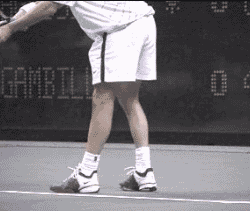<% ns_puts [mkm_getnavbar] %>

The Myth of the Back Foot
by John Yandell
Still Photos by J Gregory Swendsen
The Modern Serve
The advent of the modern serve dates from the change in this rule. The
rule was relaxed so that players were no longer required to keep one foot
on the ground at contact. Players could now leave the ground with both
feet, so long as they did not touch down in the court until after the hit.
This opened the way for a major bio-mechanical advance in serving, as the
top players found they could now get their legs much more involved in the
motion. They could now coil their legs fully with much deeper knee bends.
As they uncoiled, they naturally exploded upward and outward into the air
over the court, making contact with both feet off the ground.
Intuitively they all learned to land on the front foot, and to kick the
back foot backwards for balance—without any advice from coaches or
teaching pros. The transition, which has gone largely unnoticed and/or
analyzed, is a testament to the natural physical intuition of the top
players.
The additional kinetic force from this new leg action gave players more
power and spin. It also produced a contact point that was up to several
inches higher and also further forward, changing the trajectories of the
serve slightly and allowing players to hit even harder.
It got the serve and volleyers like Stefan Edberg, John McEnroe and Pete Sampras into the court and closer to the net sooner, since they landed a foot or more inside the baseline on the front foot. After this front foot landing, their next step with the back foot could put them closer to the service line than with the old pattern.
|
The great baseliners such as Bjorn Borg, Jimmy Connors, and Ivan Lendl
also adopted the front foot landing, undoubtedly due to the increased
power, spin, and better contact point. With very few exceptions, it has been virtually universal
on both the men’s and women’s sides in
the modern pro game.
Andre Agassi is a classic example of how players use their legs to
serve in the current pro game. He has an extremely deep knee bend and
amazing leg drive up into the ball. Our high speed video shows he actually
gets more “air” than any player on the tour, including taller, big servers
like Sampras, Rusedski, or Andy Roddick.
Serve Like the Pros
Let’s see how you can learn to use your legs like the pros, usually without having to make any other changes in your basic motion.
The first step is to do a simple test and see how much knee bend you can
comfortably develop. Start in your serving stance. Now raise your back
foot off the ground so you are standing on your front foot. Slowly bend
your knees and lower your body.
Stand completely straight up and down at the waist and see how far down
you can go. Don’t force it, and don’t cheat by bending over. Not everyone
can have Pete’s knee bend. Drop your weight down on the front foot and
find out how far you can comfortably bend. Your trying to gauge your
ability to use a key link in the bio-mechanical chain.
Lower yourself as far down as you comfortably can without completely
locking up your leg muscles. That’s your natural “coil,” and that’s the
leg action you can add to your serve.
Now drop down again to this new knee bend position. From there, hop upward
and forward into the court, and land on your front leg. Your front foot
will naturally turn forward so your toes point more or less at the net.
Do it a few times for feel and then pay attention to your back leg. You
may already be naturally kicking it back. If not, as you hop forward, kick
your back leg backwards away from you at about a 30 to 45 degree angle.
Don’t worry about how far you kick the back leg back. That will vary, depending on your natural knee bend, your flexibility, etc. Again, don’t force it.
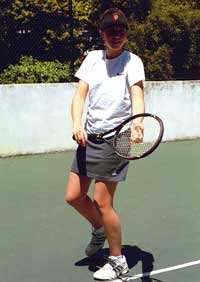 |
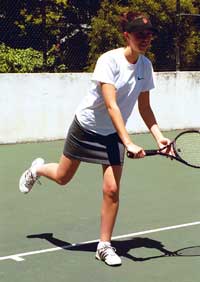 |
First test your natural ability to coil your legs (left). Now practice the hop, landing on balance on your front foot (right). |
|
Now practice both parts of the “coil and hop.” Make sure that you can land on balance with your torso still straight up and down, without having to take additional steps.
If you need to, take another hop step to find your balance. Keep the back
foot back. Don’t let it cross over and come forward. Just hop forward for
a step or two on the front foot until you stabilize your balance.
Practice until you are able to land on balance consistently. Now you’re
ready to incorporate the leg action into your serve.
First you have to figure out when to start the bend. The timing of the
bend is important. There are several potential variations, but you
definitely do not want it to start too soon.
Watch Pete, for example. He’s one of the slowest to start the bend. His
knee bend doesn’t really start until after the ball has left his tossing
hand. Mark Phillippousis has a similar timing.
Agassi on the other hand starts his bend in the middle of his tossing
motion, but well before the release. Goran Ivanisevic starts his bend a
little sooner still, at the very start of the upward motion of his tossing
arm.
If you have a very quick motion, that’s the absolute soonest you’d want to
start the bend—when the tossing arm starts upward. Players are often taught to
start the bend as the tossing arm drops, but they tend to develop a kind
of double pump, in which they bend, but then come up, and then try to bend
again.
The exact timing of the knee bend is related to the height of the toss. It’s also related to the depth of the knee bend, the amount of shoulder turn in your motion, and your personal serving rhythm. The higher the toss, obviously, the more time you have to complete the motion. The more complex the motion, or the slower your rhythm, the more time you need.
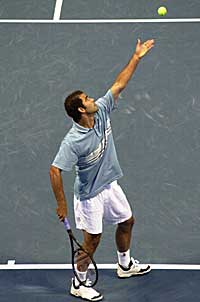 |
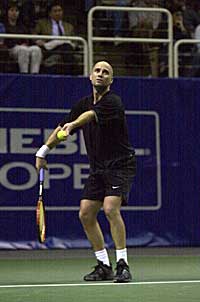 |
Pete starts his knee bend after releasing the toss. Agassi starts before the release with his tossing arm on the way up. |
|
Sampras and Philippoussis have big body turns and relatively slow rhythms.
Both toss the ball up to two feet above the contact point (See
Myth of the
Toss) and hit the ball on the way down.
Agassi’s has a quicker motion and somewhat less turn. His toss still drops
about a foot or a foot and a half.
Ivanisevic has the most minimal motion
of any top player and his toss drops only a few inches.
If you haven’t had significant knee bend in your serve up
until now, you will have to experiment with the height of your toss to
find the right timing.
If you are adding a lot of bend for the first time,
you may find you need to toss higher to avoid feeling rushed.
The key to the timing is to feel relaxed and to maximize your knee bend
when you reach the so-called “trophy” or power position. Your knee bend
should reach the deepest point when your tossing arm is fully extended and
your racquet is pointing more or less directly upwards.
It's important to note how top players keep some of their weight back, or
on their back foot at this point. In the trophy position it is inevitable
that most of the weight is on the front foot, but note that both Pete and
Agassi keep the back foot mainly on the court surface. Some percentage of
their weight is still on that foot as they start to uncoil.
Having this particular weight distribution at the bottom of the knee bend seems to play an important role in maximizing the transfer of energy into the ball at impact. You can develop this by focusing on the feeling of contact with the court with the back foot. You actually have the sensation of keeping part of your weight "back." You can feel it pressing down somewhat on the court. You'll probably notice more pop on the ball when you get the feeling of doing this.
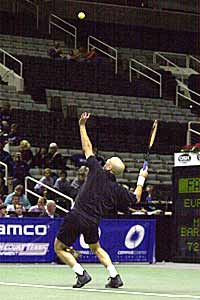 |
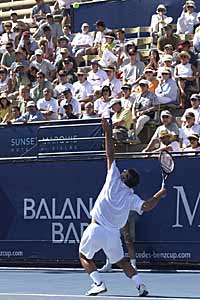 |
With their legs fully coiled both players keep the rear foot mostly on the court, with some weight still "back." |
|
One of the best things about learning this pattern is that it makes the use of the legs automatic. If the coil is right, the legs almost take care of themselves. You can just concentrate on executing the rest of your natural service motion.
As you
move the racquet through the swing pattern you’ll naturally uncoil the legs
and come up off the ground, making contact in the air over the court. As
you leave the ground, just give that back leg a little “kick” back away
from you at about 45 degrees.
Practice incorporating this into the whole service motion until you can
make a balanced landing on the front foot. Your torso should be more or
less straight up and down. Again, you should be able to land on the front
foot with just the hop and hold your balance. If you’re off balance,
again, take another small hop or two with the front foot until you can
stop on balance, but don’t let your back leg swing around or take a step
forward!
Once you get the feel of this coiling and uncoiling and it happens in sync with the rest of your motion, you will naturally generate more pace and probably more spin too. It may not feel like your working as hard though, because rather than trying to muscle the motion with your arm, you’re using the larger muscle groups to increase your leverage. You will probably notice the difference in the quality of the ball you produce—and so will your opponents. Just be careful not to try too hard.
Want to see more high speed video of the serves of top players as well as other strokes? Click here for info on Advanced Tennis high speed digital videos. |
This coiling and uncoiling of the legs helps explain how Sampras serves consistently great percentages and always seems to come up with a big serve when he needs it. He doesn’t have to “try” or do anything special. His motion automatically produces racquet head speed as a result of the forces he generates in the bio-mechanical chain, starting with his knee bend.
This is something you should strive for as well. Most players are far too tense in the arm and shoulder in the effort to generate power. Once you learn to use your legs, it can help you to relax your arm—and that can mean more consistency, especially under pressure.
It’s a great feeling to know you can count on your serve and you can produce your best deliveries when you need them. Develop this pro footwork pattern and you’ll probably start to do that on a more regular basis!
Last Updated 5/15/02. To contact us, please email to: webmaster@tennisone.com
TennisONE is a registered trademark of TennisONE and SportsWeb ONE; Copyright 1995. All rights reserved.

